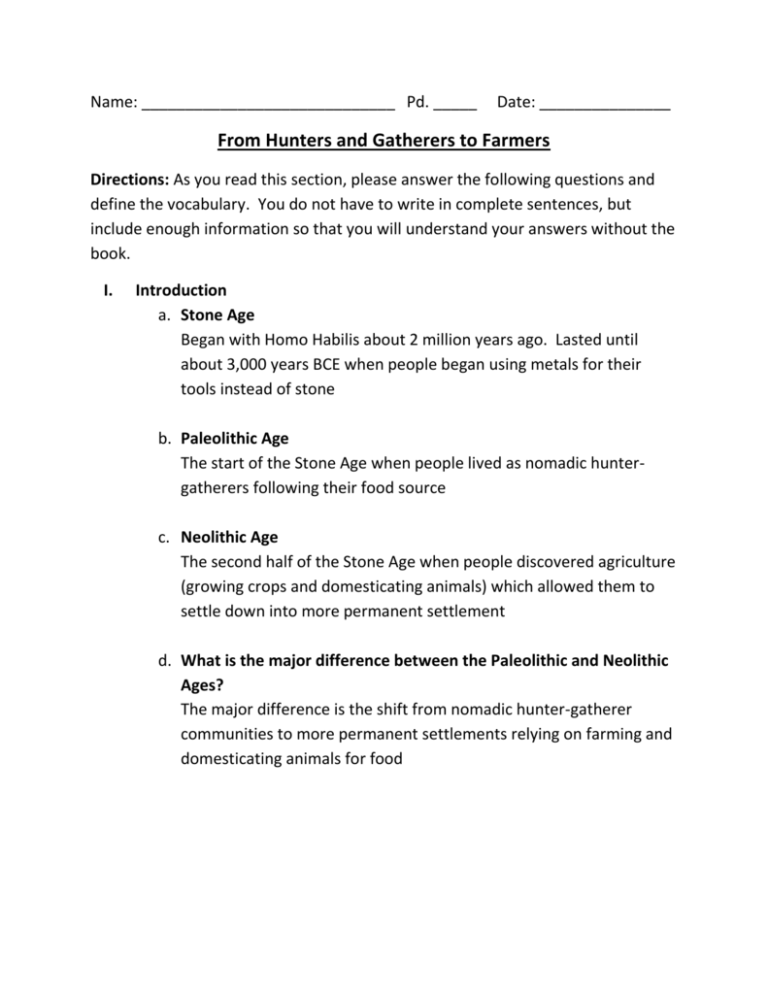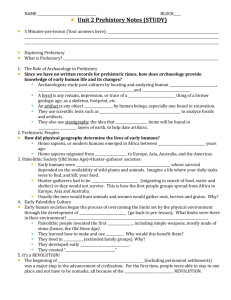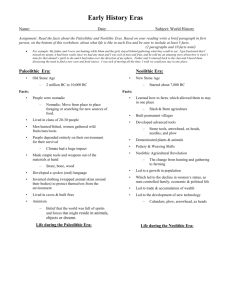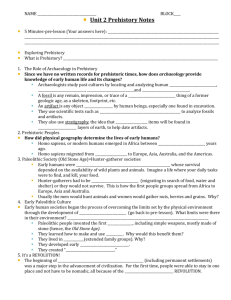Name: Pd. _____ Date: From Hunters and Gatherers to Farmers
advertisement

Name: _____________________________ Pd. _____ Date: _______________ From Hunters and Gatherers to Farmers Directions: As you read this section, please answer the following questions and define the vocabulary. You do not have to write in complete sentences, but include enough information so that you will understand your answers without the book. I. Introduction a. Stone Age Began with Homo Habilis about 2 million years ago. Lasted until about 3,000 years BCE when people began using metals for their tools instead of stone b. Paleolithic Age The start of the Stone Age when people lived as nomadic huntergatherers following their food source c. Neolithic Age The second half of the Stone Age when people discovered agriculture (growing crops and domesticating animals) which allowed them to settle down into more permanent settlement d. What is the major difference between the Paleolithic and Neolithic Ages? The major difference is the shift from nomadic hunter-gatherer communities to more permanent settlements relying on farming and domesticating animals for food II. From Old Stone Age to New Stone Age a. When did the Neolithic Age start according to historians, and what do they point to as evidence? (provide 2 specific examples) The Neolithic Age started about 8,000 BCE when people began to farm crops and domesticate animals. The first permanent settlements were established because of this change: 1. Catal Hoyuk 2. Jarmo 3. Jericho b. When did the Neolithic Age end according to historians, and what do they point to as evidence? The Neolithic Age ended around 3,000 BCE when people learned to make tools and weapons out of metals instead of stone c. What was this new age called? (This answer is not in the reading. Use your head and think about what you read.) The Bronze Age (when people relied heavily on bronze weapons and tools) III. Creating a Stable Food Supply a. Domesticate Raising and using animals for food and to do work for humans b. Agriculture (use definition in paragraph) The growing of crops and the domestication of animals to produce food c. What problems did a steady food supply help to solve for early man? Think about both the domestication of animals and the growing of specific crops. 1. Hunting and gathering didn’t guarantee food all year round 2. Wild plants and animals would vanish if people hunted and gathered too much in one area 3. Hunting was a dangerous activity IV. Making Permanent Shelters a. What was the first major change to occur after the Agricultural Revolution and why was it possible? The first change was the creation of permanent shelters and they were possible because people were staying put rather than following herds of animals around b. Name at least 3 advantages of permanent shelters. Place them in what you feel is the order of most important to least important. 1. Allowed people to form larger communities 2. Protection from harsh weather 3. Protection from wild animals 4. Made life more comfortable 5. Allowed new ways of cooking c. Think: Why do you think all openings (i.e. windows and doors) were placed so high on the building that ladders were needed to get in and out? The openings were placed so high up so that wild animals and unwelcome people couldn’t enter the home V. Establishing Communities a. Describe the benefits of living in permanent communities. 1. One of the most important benefits of living in permanent communities was the opportunity to specialize in something. You didn’t have to learn how to do everything, but could instead learn how to do one thing, very well. 2. The work was divided among the people. Work was done quicker, and allowed for other pursuits, like advancing technology. 3. There was also power in numbers as it was easier to defend yourself in large groups. b. “Living in communities allowed people to organize themselves more efficiently”. This is known as specialization, and is very important to the new way of life Neolithic Era people lived. What did this allow people to do? (Please list at least 3 specific advantages). 1. Specialization allowed for people to become much better at one job, and not spend all their time looking for food 2. It freed up much more time and allowed people to focus more energy on advancing technology 3. It created a surplus of products to begin trading with VI. Developing New Jobs a. Describe four new specialized jobs found in an early permanent settlement. 1. Farmers – grew 6. Miners – food for the harvested flint settlement and other 2. Weavers – made resources clothes and 7. Potters – made textiles clay tools like 3. Basket makers – pots made baskets 8. Jewelers – made 4. Toolmakers – jewelry and made tools mirrors 5. Traders – traded 9. House builders – goods with other built homes settlements b. Why weren’t nomadic people able to specialize like early man was able to in these permanent settlements? A person’s main job during the Paleolithic Age was to find food and provide for their basic needs. Farming during the Neolithic Age allowed people to focus on other things and not worry about where their food was coming from VII. Beginning to Trade a. Trade The business of buying and selling, or exchanging goods b. Ore A mineral mined for its valuable uses c. Why was trade less important to a hunter gatherer than it became for early settlement dwellers? When people were nomadic they would use the resources of the areas where they move to. When people stopped moving around, they needed or wanted resources from faraway places. d. What important effect did trade have on early settlements? Trade allowed people to use more resources, but it also kept people in contact with other settlements and created a way to spread ideas and knowledge all over the ancient world.








